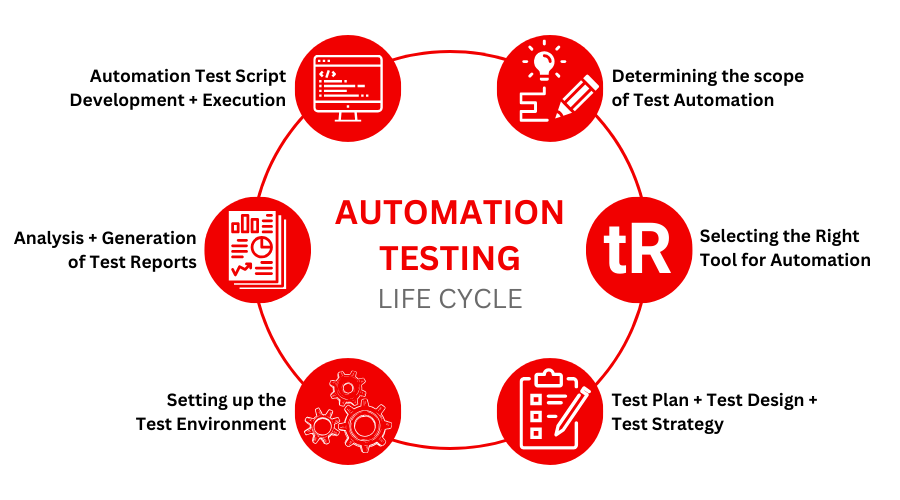Choosing the Right Tools for Effective Automation Testing Solutions
Wiki Article
From Manual to Automated Testing: A Comprehensive Guide to Transitioning Smoothly and Effectively
In the realm of software program testing, the change from guidebook to automated procedures has actually come to be a significantly vital transition for companies seeking to improve effectiveness and precision in their testing practices. As technology continues to advance, the need for reliable and smooth computerized screening techniques has never been extra important. The trip from handbook to automated testing is not without its obstacles, however when come close to purposefully and with a clear strategy in mind, the advantages can be substantial - automation testing. In this extensive guide, we will discover key steps and factors to consider crucial for a successful change, from the initial selection of devices to the assimilation of automation into existing workflows. Keep tuned to discover the insights that will certainly assist pave the means for a smoother and more reliable screening process.Benefits of Automated Evaluating
Automated testing supplies numerous advantages, boosting effectiveness and accuracy in software application growth procedures. One key advantage is the considerable decrease in testing time. Automated tests can be run concurrently on multiple tools and operating systems, dramatically speeding up the testing phase contrasted to hand-operated testing. This raised efficiency allows for faster feedback on the top quality of the software program, enabling programmers to identify and resolve problems quickly.In addition, automated screening makes sure a higher level of precision in detecting issues. Consistency in screening is also improved, as automated examinations perform the same steps specifically each time they are run.
Choosing the Right Tools

To start with, assess your needs and objectives. Recognize the extent of your project, the technologies entailed, and the capability of your group. This analysis will assist you determine the abilities and features you need in your screening devices.
Secondly, take into consideration the compatibility of the tools with your existing systems and processes. Smooth assimilation with your present software program development lifecycle is important to guarantee a smooth transition to automation.
Additionally, examine the scalability and flexibility of the tools. As your testing needs advance, the devices need to be able to adjust and suit adjustments properly.
Finally, factor in the assistance and area around the devices. Durable support and an active customer neighborhood can supply useful resources and aid when executing automated screening. By very carefully considering these aspects, you can pick the right tools that align with your demands and set the phase for an effective shift to automated testing.
Writing Efficient Examination Scripts

When crafting test scripts, it is crucial to think about the particular requirements of the software application being tested and ensure that the manuscripts attend to all vital functionalities. Clear and detailed naming conventions for test manuscripts and examination situations can improve readability and maintainability. Additionally, integrating mistake handling devices within the examination scripts can help in identifying and resolving concerns quickly.
In addition, organizing examination manuscripts into modular elements can boost reusability and scalability, reducing redundancy and boosting performance in examination script upkeep. Regular evaluations he has a good point and updates to check manuscripts are important to maintain rate with progressing software demands and performances. By adhering to these concepts, testers can create robust and efficient examination manuscripts that contribute considerably to the success of automated testing procedures.
Integrating Automation Into Workflows
By flawlessly incorporating automated testing devices like Selenium or Appium into the software program advancement lifecycle, teams can attain faster feedback on code adjustments, leading to quicker insect detection and resolution. This integration permits for continuous screening throughout the advancement procedure, guaranteeing that any kind of problems are recognized early on, resulting in higher software program top quality. Appropriate assimilation of automation tools calls for collaboration between growth, testing, and operations groups to establish a unified process that maximizes efficiency and efficiency in supplying top quality software program products.Making Sure a Smooth Change
Successfully transitioning to automated testing entails meticulous planning and cautious implementation to minimize disturbances and optimize performance in visit this page the software development process - automation testing. To make sure a smooth change, it is necessary to start by carrying out a thorough assessment of the present screening procedures and recognizing locations where automation can bring the most substantial advantages. Involving with all stakeholders beforehand in the process, including developers, testers, and project managers, is essential for garnering support and buy-in for the automation effortCommunication is crucial during this change phase. Clear interaction of the objectives, advantages, and assumptions of automated screening assists to take care of any type of resistance or worries that may develop. Furthermore, offering ample training and sources for employee to upskill in automation tools and techniques is vital for ensuring an effective change.

Final Thought
view website To conclude, transitioning from manual to automated screening uses numerous advantages, consisting of raised effectiveness and reliability. By choosing the appropriate devices, writing efficient test manuscripts, and incorporating automation perfectly into operations, organizations can make certain a effective and smooth transition. It is necessary to accept automation as a useful possession in software program testing procedures to improve total high quality and performance.In the realm of software application screening, the change from manual to automated procedures has come to be a significantly essential shift for organizations looking for to enhance efficiency and accuracy in their testing methods. Automated examinations can be run all at once on several devices and running systems, dramatically speeding up the screening phase compared to manual screening. Uniformity in screening is also enhanced, as automated examinations perform the exact same steps precisely each time they are run.To make certain the effective implementation of picked screening devices, the production of reliable examination scripts plays a crucial role in confirming the performance and efficiency of automated processes - automation testing. By following these concepts, testers can create reliable and robust examination scripts that add substantially to the success of automated testing procedures
Report this wiki page